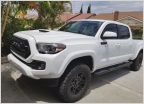-
Welcome to Tacoma World!
You are currently viewing as a guest! To get full-access, you need to register for a FREE account.
As a registered member, you’ll be able to:- Participate in all Tacoma discussion topics
- Communicate privately with other Tacoma owners from around the world
- Post your own photos in our Members Gallery
- Access all special features of the site
Chasing high pressure fuel - a pump comparison and upgrade?
Discussion in '3rd Gen. Tacomas (2016-2023)' started by Jowett, Aug 11, 2022.
Page 1 of 2
Page 1 of 2


 Security System
Security System Post your TRD Pro....seur!
Post your TRD Pro....seur! Anyone try auto Snow Socks?
Anyone try auto Snow Socks? Dog transportation - I’m new
Dog transportation - I’m new











































































